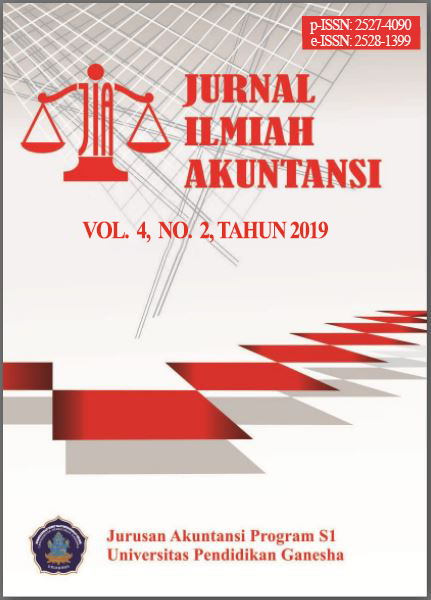Pengaruh Siklus Hidup Perusahaan dan Corporate Social Responsibility terhadap Kebijakan Cash Holding dengan Diversifikasi Geografis sebagai Variabel Moderasi
DOI:
https://doi.org/10.23887/jia.v4i2.19419Abstract
Latar belakang masalah penelitian ini adalah sulitnya menentukan tingkat cash holding yang optimal untuk memenuhi aktivitas bisnis perusahaan. Penelitian ini menyelidiki bagaimana pada berbagai tahapan dalam siklus hidup perusahaan dan Corporate Social Responsibility memengaruhi keputusan cash holding dan peran diversifikasi geografis sebagai variabel moderasi. Metode yang digunakan dalam penelitian ini adalah pendekatan kuantitatif. Data yang digunakan adalah data sekunder perusahaan manufaktur yang terdaftar di Bursa Efek Indonesia periode 2013-2017. Pengambilan sampel menggunakan teknik purposive sampling, terpilih 185 perusahaan sebagai sampel.Data dianalisis menggunakan metode analisis MRA (Moderated Regression Analysis). Hasil penelitian menunjukkan bahwa siklus hidup perusahaan di fase pengenalan berpengaruh negatif terhadap cash holding, siklus hidup perusahaan di fase pertumbuhan tidak berpengaruh terhadap cash holding, siklus hidup perusahaan di fase kedewasaan tidak berpengaruh terhadap cash holding, siklus hidup perusahaan di fase penurunan tidak berpengaruh terhadap cash holding. Diversifikasi geografis tidak secara signifikan memoderasi hubungan antara siklus hidup perusahaan di fase pertumbuhan dan cash holding. Diversifikasi geografis secara signifikan memoderasi hubungan antara CSR dan cash holding.
References
Alzoubi, T. (2019). Firms’ Life Cycle Stage and Cash Holding Decisions. Academy of Accounting and Financial Studies Journal, 23(1), 1–8.
Ambarwati, N. S., Yuniarta, G. A., & Sinarwati, N. K. (2015). Pengaruh Modal Kerja, Likuiditas, Aktivitas Dan Ukuran Perusahaan Terhadap Profitabilitas Pada Perusahaan Manufaktur Yang Terdagtar Di Bursa Efek Indonesia. E-Journal S1 Ak Universitas Pendidikan Ganesha.
Bates, T. W., Kahle, K. M., & Stulz, R. M. (2009). Why do U.S. firms hold so much more cash than they used to? Journal of Finance. https://doi.org/10.1111/j.1540-6261.2009.01492.x
Beckhart, B. H., & Keynes, J. M. (1936). The General Theory of Employment, Interest and Money. Political Science Quarterly. https://doi.org/10.2307/2143949
Brammer, S. J., Pavelin, S., & Porter, L. A. (2006). Corporate social performance and geographical diversification. Journal of Business Research. https://doi.org/10.1016/j.jbusres.2006.04.001
Cheung, A. W. K. (2016). Corporate social responsibility and corporate cash holdings. Journal of Corporate Finance. https://doi.org/10.1016/j.jcorpfin.2016.01.008
cnn indonesia. (n.d.).
Coulton, J. J., & Ruddock, C. (2011). Corporate payout policy in Australia and a test of the life-cycle theory. Accounting and Finance. https://doi.org/10.1111/j.1467-629X.2010.00356.x
Drobetz, W., Halling, M., & Schröder, H. (2015). Corporate Life-Cycle Dynamics of Cash Holdings.
Faff, R., Kwok, W. C., Podolski, E. J., & Wong, G. (2016). Do corporate policies follow a life-cycle? Journal of Banking and Finance. https://doi.org/10.1016/j.jbankfin.2016.04.009
Fombrun, C. J., Gardberg, N. A., & Sever, J. M. (2000). The Reputation QuotientSM: A multi-stakeholder measure of corporate reputation. Journal of Brand Management. https://doi.org/10.1057/bm.2000.10
Ghozali, I. (2011). Aplikasi Analisis Multivariate Dengan Program IBM SPSS 19. Semarang: Badan Penerbit Universitas Diponegoro.
Gill, A., Biger, N., Mand, H. S., & Shah, C. (2012). Analysis of Factors Affecting Share Prices: The Case of Bahrain Stock Exchange. International Journal of Economics & Finance. https://doi.org/10.5539/ijef
Iskandar-Datta, M. E., & Jia, Y. (2012). Cross-country analysis of secular cash trends. Journal of Banking and Finance. https://doi.org/10.1016/j.jbankfin.2011.10.003
Jensen, M. C., & Smith, Jr., C. W. (2005). The Theory of Corporate Finance: A Historical Overview. SSRN Electronic Journal. https://doi.org/10.2139/ssrn.244161
Jovanovic, B., & Macdonald, G. M. (1994). The life cycle of a competitive industry. Journal of Political Economy. https://doi.org/10.1086/261934
Jovanovic, Boyan. (1982). Selection and the Evolution of Industry. Econometrica, 50(3), 649–670. https://doi.org/10.2307/1912606
Kang, J. (2013). The relationship between corporate diversification and corporate social performance. Strategic Management Journal, 34(1), 94–109. https://doi.org/10.1002/smj.2005
Kim, Y., Park, M. S., & Wier, B. (2012). Is earnings quality associated with corporate social responsibility? Accounting Review. https://doi.org/10.2308/accr-10209
Kotler, P. (2000). Manajemen Pemasaran Edisi Milenium 1. Jakarta: PT Ikrar Mandiriabadi.
Liestyasih, L. P. E., & Wiagustini, L. P. (2017). PENGARUH FIRM SIZE DAN GROWTH OPPORTUNITY TERHADAP CASH HOLDING DAN FIRM VALUE. E-Jurnal Ekonomi Dan Bisnis Universitas Udayana. https://doi.org/10.24843/eeb.2017.v06.i10.p07
Lu, J. W., & Beamish, P. W. (2004). International diversification and firm performance: The S-curve hypothesis. Academy of Management Journal. https://doi.org/10.5465/20159604
Martínez-Sola, C., García-Teruel, P. J., & Martínez-Solano, P. (2013). Corporate cash holding and firm value. Applied Economics. https://doi.org/10.1080/00036846.2011.595696
Opler, T., Pinkowitz, L., Stulz, R., & Williamson, R. (1999). The determinants and implications of corporate cash holdings. Journal of Financial Economics. https://doi.org/10.1016/s0304-405x(99)00003-3
Roberts, P. W., & Dowling, G. R. (2002). Corporate reputation and sustained superior financial performance. Strategic Management Journal. https://doi.org/10.1002/smj.274
Saddour, K. (2006). The Determinants and the Value of Cash Holdings: Evidence from French firms. Cahier de Recherche CEREG.
Sharfman, M. P., Shaft, T. M., & Tihanyi, L. (2004). A Model of the Global and Institutional Antecedents of High-Level Corporate Environmental Performance. Business & Society. https://doi.org/10.1177/0007650304262962
Subramaniam, V., Tang, T. T., Yue, H., & Zhou, X. (2011). Firm structure and corporate cash holdings. Journal of Corporate Finance, 17(3), 759–771. https://doi.org/10.1016/j.jcorpfin.2010.06.002
Sutrisno, S. (2017). PENGUKURAN KESEHATAN BANK SYARIAH DENGAN SHARIA COMPLIENCE AND PERFORMANCE. Jurnal Keuangan Dan Perbankan. https://doi.org/10.26905/jkdp.v21i1.1234
Teece, D. J. (1982). Towards an economic theory of the multiproduct firm. Journal of Economic Behavior and Organization. https://doi.org/10.1016/0167-2681(82)90003-8
William, W., & Fauzi, S. (2013). Analisis Pengaruh Growth Opportunity, Net Working Capital, Dan Cash Conversion Cycle Terhadap Cash Holdings Perusahaan Sektor Pertambangan. Jurnal Ekonomi Dan Keuangan.
Yi, M. Y., Jackson, J. D., Park, J. S., & Probst, J. C. (2006). Understanding information technology acceptance by individual professionals: Toward an integrative view. Information and Management. https://doi.org/10.1016/j.im.2005.08.006



1.png)


